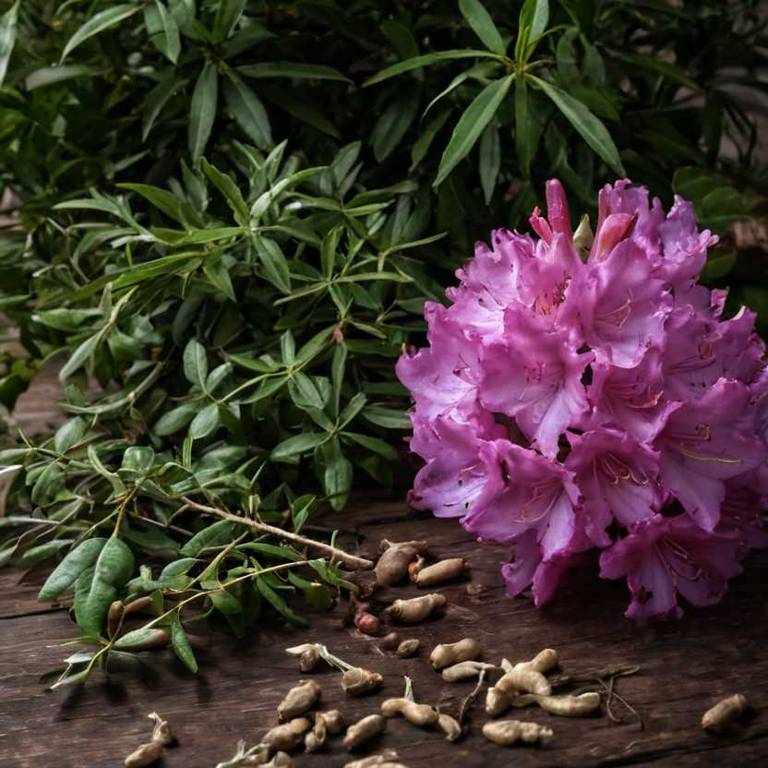By Leen Randell
Updated: Jul 06, 2024
What to know about Rhododendron caucasicum (caucasian rhododendron) before using it medicinally

Rhododendron caucasicum, commonly known as Caucasian rhododendron, is a versatile herb that has been used for centuries to alleviate various health issues, including reducing inflammation and improving cardiovascular health due to its high flavonoid content.
As an ornamental plant, it is prized for its stunning pink and white flowers that bloom in late spring, and its evergreen leaves provide a pop of color in the winter months, making it a favorite among gardeners. Botanically, Rhododendron caucasicum belongs to the Ericaceae family and is a member of the subgenus Rhododendron, with a unique floral structure and leaf morphology.
The herb has been mentioned in ancient Greek and Roman texts, with the Greek physician Dioscorides being one of the earliest known references to its medicinal properties.
This article explains the medicinal, horticultural, botanical, and historical aspects of Rhododendron caucasicum.
What are the medicinal properties of Rhododendron caucasicum?
Rhododendron caucasicum helps with various ailments, including digestive issues, fever, and inflammation, due to its antimicrobial, antipyretic, and anti-inflammatory properties. It has been used to treat diarrhea, dysentery, and respiratory problems. Its leaves and flowers are used in traditional medicine.
The plant's medicinal properties are attributed to the presence of flavonoids, glycosides, and phenolic acids, which have been identified as the active constituents responsible for its health benefits. These compounds have been isolated and studied for their antioxidant, anti-inflammatory, and antimicrobial activities.
The most commonly used parts of the plant for medicinal purposes are its leaves, flowers, and roots, which are used in teas, infusions, and decoctions. The leaves and flowers are used to treat fever, inflammation, and digestive issues, while the roots are used to treat respiratory problems and as a purgative.
Improper use of Rhododendron caucasicum can lead to side effects such as gastrointestinal irritation, allergic reactions, and interactions with other medications. Ingestion of large quantities can cause vomiting, diarrhea, and abdominal pain.
When using Rhododendron caucasicum medicinally, precautions should be taken to avoid interactions with other medications, particularly blood thinners and diuretics. Pregnant and breastfeeding women should consult a healthcare professional before using the plant. Additionally, the plant's extracts should be standardized to ensure consistent potency and safety.
What are the horticulural aspects of Rhododendron caucasicum?
Rhododendron caucasicum grow well in USDA zones 6-8, preferring moist, acidic soils with good drainage and partial to full shade. They thrive in environments with mild winters and cool summers. They can tolerate some drought but perform best with consistent moisture. Temperatures above 75°F can cause damage.
Proper planting of Rhododendron caucasicum requires a location with protection from strong winds and extreme weather conditions. Planting should occur in spring or fall, avoiding extreme temperatures. Dig a hole 2-3 times wider and as deep as the root ball, mixing in compost or peat moss to improve drainage and fertility.
Harvesting flowers of Rhododendron caucasicum typically occurs in late spring to early summer, when buds have swelled and started to open. Cut or pinch off spent flowers to encourage repeat blooming. Prune branches after blooming to maintain shape, promote new growth, and increase flower production. Remove dead or diseased branches.
Common pests of Rhododendron caucasicum include aphids, whiteflies, and spider mites, which can cause damage and disease. Fungal diseases such as root rot, leaf spot, and petal blight can also affect the plant, often caused by overwatering, poor drainage, or high humidity. Regular monitoring and prompt treatment can help prevent damage.
What are the botanical aspects of Rhododendron caucasicum?
Rhododendron caucasicum, also known as Caucasian Rhododendron, is a flowering evergreen shrub or small tree with glossy, dark green leaves and showy, funnel-shaped flowers. It typically grows 2-6 meters tall and 3-6 meters wide. Leaves are elliptical to ovate, 10-20 cm long, with 6-12 veins.
Taxonomically, Rhododendron caucasicum belongs to the family Ericaceae, subfamily Ericoideae, tribe Rhodoreae. It is part of the genus Rhododendron, which comprises over 1,000 species. The plant's scientific name is derived from the Greek words "rhodon" meaning rose and "dendron" meaning tree.
Variants of Rhododendron caucasicum include R. caucasicum var. caucasicum and R. caucasicum var. rhodanthum, which differ in leaf shape and size. Other variants may have distinct flower colors or growth habits.
Native to the Caucasus region, Rhododendron caucasicum is found in the mountainous areas of Russia, Georgia, and Azerbaijan. It grows in well-drained soils and acidic to neutral pH conditions. It thrives at high elevations, typically between 1,500-3,000 meters above sea level.
The life cycle of Rhododendron caucasicum begins with seed germination, typically occurring in spring. Young seedlings develop into juvenile plants, producing vegetative shoots and roots. As the plant matures, it produces flowers and sets seed, completing its reproductive cycle. This process can take several years to several decades.
What are the historical aspects of Rhododendron caucasicum?
Rhododendron caucasicum is a plant with a long history of use in traditional medicine, particularly in the Caucasus region. Its flowers, leaves, and roots have been employed to treat various ailments, including fever, rheumatism, and gastrointestinal issues.
In ancient mythology, Rhododendron caucasicum was associated with the gods of the Caucasus, who were said to have used its flowers in their rituals. In some stories, the plant's beauty and fragrance were also said to have inspired the creation of the world.
The symbolic meanings of Rhododendron caucasicum have varied across cultures. In the Caucasus region, it was seen as a symbol of hospitality and generosity, as its flowers were often used to welcome guests. In other cultures, the plant was associated with love, fertility, and beauty.
Historical texts, such as the 17th-century herbalist Leonhard Fuchs' book "De historia stirpium", mention Rhododendron caucasicum as a plant with medicinal properties. The plant's name appears in various manuscripts and codices from the Middle Ages.
Rhododendron caucasicum has been depicted in numerous historical artifacts, including ancient pottery, frescoes, and illuminated manuscripts. Its image can also be found in traditional Caucasian embroidery and textiles.